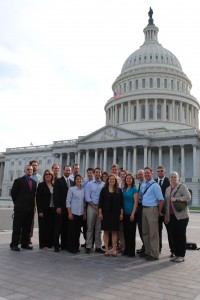 On June 15, eleven beginning farmers and ranchers from across the country arrived in Washington, DC to tell legislators what measures our country can take to support beginning farmers and ranchers. Anticipating the 2012 Farm Bill process, beginning farmers and ranchers sought support for a marker bill with a package of provisions for beginning farmer and rancher development.
On June 15, eleven beginning farmers and ranchers from across the country arrived in Washington, DC to tell legislators what measures our country can take to support beginning farmers and ranchers. Anticipating the 2012 Farm Bill process, beginning farmers and ranchers sought support for a marker bill with a package of provisions for beginning farmer and rancher development.
The beginning farmers and ranchers, along with staff from NSAC, Land Stewardship Project, Center for Rural Affairs, Nebraska Sustainable Agriculture Society, and California FarmLink, conducted over fifty visits on Capitol Hill in the space of two days. Meeting in House and Senate offices, the participants spoke with Members of Congress and their staff about the challenges that face beginning farmers and how the Farm Bill could provide opportunities for new farm entry and sustainable economic growth in rural communities.
On Thursday, June 16, the participants visited USDA to meet with Deputy Secretary Kathleen Merrigan. The Deputy Secretary was accompanied by Brandon Willis, a key staff person for Secretary Tom Vilsack, and Poppy Davis, Office of Advocacy and Outreach Program Leader for Small Farms and Beginning Farmers and Ranchers.
Among the many specific programs and proposed provisions that the beginning farmers highlighted in their visits were:
- The Beginning Farmer and Rancher Development Program, a highly successful extension and training competitive grants program that is helping to fund innovative projects around the country to train and support the next generation of farmers. The marker bill will propose renewed and increased funding for the program.
- Individual Development Accounts, a matched savings account that works with beginning farmers to help them meet a financial goal to start or expand their business; this program was authorized in the 2008 Farm Bill but never funded. Several states have successful pilot programs using private funding. The marker bill will propose $5 million a year in mandatory funding.
- Conservation funding set-aside, which currently reserves 5% of Environmental Quality Incentives Program (EQIP) and Conservation Stewardship Program (CSP) funds specifically to beginning farmers and ranchers; the bill would increase this to 10%.
- A young farmer microloan program, which would create a new simplified loan category administered by Farm Service Administration for loans under $35,000 to young beginning farmers.
“We talked about the beginning farmer and rancher [bill], and we talked to members of Congress about the the practice of what we do, we told them why it’s important to support certain programs, like the Direct Loan Program through FSA, because these programs create jobs and opportunities in rural America,” said Seth Nitschke, owner of Open Space Meats in Neuman, California. “If we didn’t have these programs, young and beginning farmers would be shut out of farming. It’s vitally important to rural America to have new blood coming into farming…without these programs we couldn’t do what we do.”
The beginning farmers and ranchers who participated in this visit are involved with NSAC member organizations across the country, including Nebraska Sustainable Agriculture Society, Practical Farmers of Iowa, California FarmLink, Land Stewardship Project, Center for Rural Affairs, The Land Connection, National Young Farmers’ Coalition, Maine Organic Farmers and Gardeners Association, and Beginning Farmers. They hailed from Maine, New York, Pennsylvania, Michigan, Illinois, Iowa, Minnesota, Nebraska, Colorado, and California, and included livestock, poultry, dairy, grain, and fruit and vegetable producers.


The beginning farmers and ranchers who participated in this visit are involved with NSAC member organizations across the country, including Practical Farmers of Iowa, California FarmLink, Land Stewardship Project, Center for Rural Affairs, The Land Connection, National Young Farmers’ Coalition, Maine Organic Farmers and Gardeners Association, and Beginning Farmers. They hailed from Maine, New York, Pennsylvania, Michigan, Illinois, Iowa, Minnesota, Nebraska, Colorado, and California, and included livestock, poultry, dairy, grain, and fruit and vegetable producers.
AND the Nebraska Sustainable Agriculture Society.